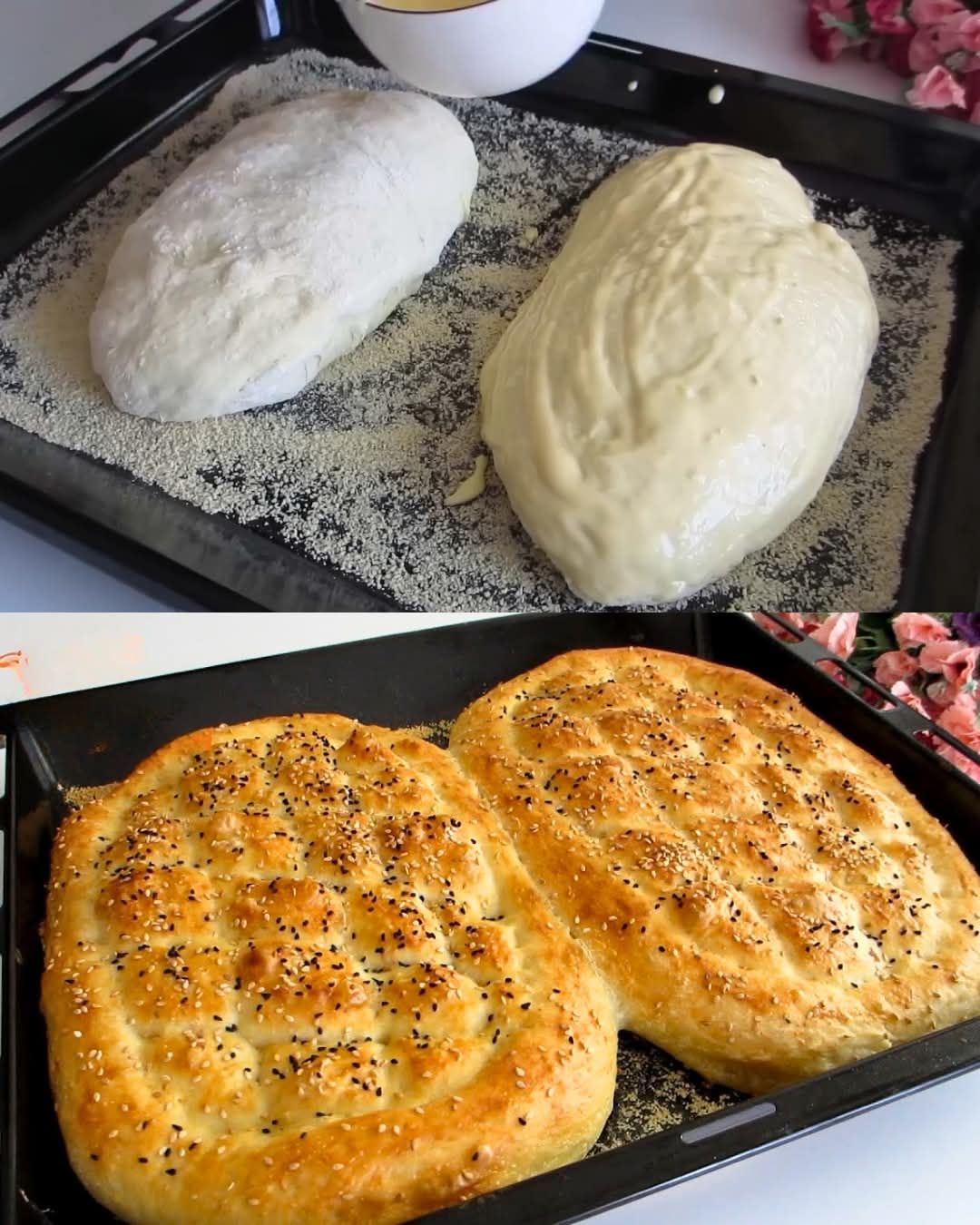Prepare the Dough:
In a large mixing bowl, combine flour, salt, dry yeast, and sugar. Mix well.
Gradually add warm water to the dry ingredients while mixing.
Once the water is absorbed, knead the dough with your hands until soft and smooth. The dough will be sticky—use flour sparingly to make handling easier.
Rest the Dough:
Cover the dough with a clean kitchen towel and let it rest in a warm environment for 30 minutes.
Shape the Dough:
After 30 minutes, the dough should have doubled in size.
Sprinkle flour on a clean counter and divide the dough into 2 equal parts.
Sprinkle breadcrumbs onto a baking tray to prevent sticking.
Place the dough pieces on the tray and gently press them into round shapes.
Add the Topping:
In a small bowl, whisk together the egg yolk and yogurt.
Generously brush this mixture over the surface of the dough.
Using your fingertips, lightly press the dough to create the classic pita pattern.
Sprinkle sesame seeds (and raisins, if desired) over the top.
Bake the Pita:
Preheat your oven to 180°C (350°F).
Bake the pita in the oven for 30 minutes, or until golden brown.
Serve:
Allow the pita to cool slightly before serving. Enjoy warm or at room temperature.
Serving Suggestions
Serve with soups, stews, or as a side to savory dips like hummus or baba ghanoush.
Pair with olive oil and za’atar for a Mediterranean touch.
Cooking Tips
Ensure the water is warm, not hot, to activate the yeast without killing it.
Use a damp cloth to cover the dough during resting to prevent it from drying out.
For a shinier crust, you can add a drizzle of olive oil before baking.
Nutritional Benefits
Flour: Provides carbohydrates for energy.
Eggs: Rich in protein and vitamins.
Sesame Seeds: Add healthy fats and a nutty flavor.
Dietary Information
Contains gluten, dairy, and eggs.
For a dairy-free version, replace yogurt with a plant-based alternative.
Nutritional Facts (Per Serving – Approx. 8 servings)
Calories: 210
Protein: 7g
Fat: 3g
Carbohydrates: 40g
Fiber: 2g
Storage
Store in an airtight container at room temperature for up to 2 days.
Freeze for up to 1 month; reheat in the oven before serving.
Why You’ll Love This Recipe
Easy to make with simple ingredients.
Soft, fluffy texture with a golden crust.
Perfect for any meal or as a snack.
A classic bread recipe steeped in tradition.
Conclusion
This Ramadan Pita Bread is a delicious and traditional recipe that’s both easy to prepare and universally loved. With its soft texture and golden crust, it’s the perfect accompaniment to any meal. Try it today and bring a taste of Turkish tradition to your table.
Frequently Asked Questions
Can I use instant yeast instead of dry yeast?
Yes, use the same amount and skip the activation step.
What can I use instead of yogurt in the topping?
Substitute yogurt with milk or a plant-based alternative.
Can I make this recipe gluten-free?
Use a gluten-free all-purpose flour blend.
Can I add herbs or spices to the dough?
Yes, rosemary, thyme, or nigella seeds can enhance the flavor.
How can I make the crust crispier?
Bake at a slightly higher temperature (200°C/392°F) for the last 5 minutes.
Can I use whole wheat flour instead?
Yes, but the texture will be denser. Use a 50/50 mix with all-purpose flour.
How do I prevent the dough from sticking during kneading?
Use a light dusting of flour or oil your hands.
Can I freeze the dough?
Yes, freeze after shaping, then thaw and bake as needed.
What if my dough doesn’t rise?
Ensure your yeast is fresh and the environment is warm enough.
How do I keep the bread soft after baking?
Cover it with a clean towel while it cools to retain moisture.
ADVERTISEMENT

